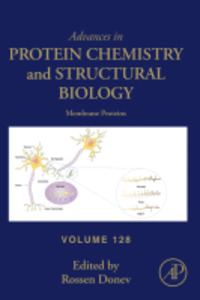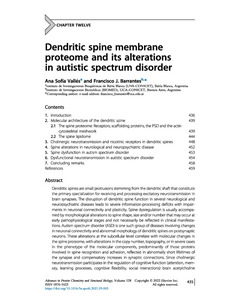Por favor, use este identificador para citar o enlazar este ítem:
https://repositorio.uca.edu.ar/handle/123456789/14438| Título: | Dendritic spine membrane proteome and its alterations in autistic spectrum disorder | Autor: | Vallés, Ana Sofía Barrantes, Francisco José |
Palabras clave: | AUTISMO; RECEPTOR DE ACETILCOLINA; SINAPTOPATIA; ESPINA DENDRITICA; SINDROME X FRAGIL; TRASTORNOS DEL ESPECTRO AUTISTA | Fecha de publicación: | 2022 | Editorial: | Academic Press | Cita: | Vallés, A.S., Barrantes, F.J. Dendritic spine membrane proteome and its alterations in autistic spectrum disorder [en línea]. En: Donev, R. (ed.). Advances in Protein Chemistry and Structural Biology: Volume 128 Membrane Proteins. Londres: Academic Press, 2022 doi:10.1016/bs.apcsb.2021.09.003 Disponible en: https://repositorio.uca.edu.ar/handle/123456789/14438 | Resumen: | Abstract: Dendritic spines are small protrusions stemming from the dendritic shaft that constitute the primary specialization for receiving and processing excitatory neurotransmission in brain synapses. The disruption of dendritic spine function in several neurological and neuropsychiatric diseases leads to severe information-processing deficits with impairments in neuronal connectivity and plasticity. Spine dysregulation is usually accompanied by morphological alterations to spine shape, size and/or number that may occur at early pathophysiological stages and not necessarily be reflected in clinical manifestations. Autism spectrum disorder (ASD) is one such group of diseases involving changes in neuronal connectivity and abnormal morphology of dendritic spines on postsynaptic neurons. These alterations at the subcellular level correlate with molecular changes in the spine proteome, with alterations in the copy number, topography, or in severe cases in the phenotype of the molecular components, predominantly of those proteins involved in spine recognition and adhesion, reflected in abnormally short lifetimes of the synapse and compensatory increases in synaptic connections. Since cholinergic neurotransmission participates in the regulation of cognitive function (attention, memory, learning processes, cognitive flexibility, social interactions) brain acetylcholine receptors are likely to play an important role in the dysfunctional synapses in ASD, either directly or indirectly via the modulatory functions exerted on other neurotransmitter receptor proteins and spine-resident proteins. | URI: | https://repositorio.uca.edu.ar/handle/123456789/14438 | ISBN: | 978-0-323-98895-7 | ISSN: | 1876-1623 | Disciplina: | MEDICINA | DOI: | 10.1016/bs.apcsb.2021.09.003 | Derechos: | info:eu-repo/semantics/closedAccess | Fuente: | Advances in Protein Chemistry and Structural Biology: Volume 128 Membrane Proteins. Londres: Academic Press, 2022 |
| Aparece en las colecciones: | Libros o partes de libro |
Ficheros en este ítem:
| Fichero | Descripción | Tamaño | Formato | |
|---|---|---|---|---|
| thumb.gif | 6,97 kB | GIF |  Visualizar/Abrir | |
| dendritic-spine-embrane.pdf | 10,92 MB | Adobe PDF |  SOLICITAR ACCESO |
Visualizaciones de página(s)
85
comprobado en 27-abr-2024
Descarga(s)
115
comprobado en 27-abr-2024
Google ScholarTM
Ver en Google Scholar
Altmetric
Altmetric
Este ítem está sujeto a una Licencia Creative Commons

